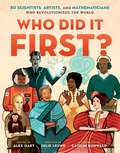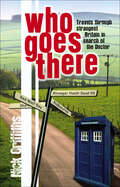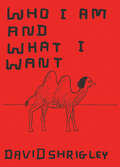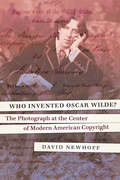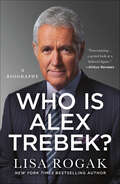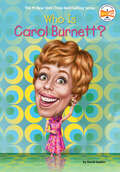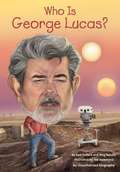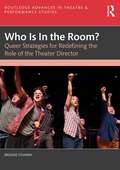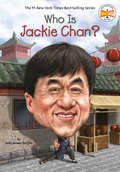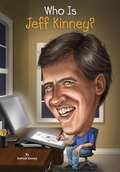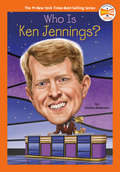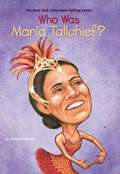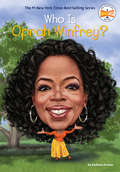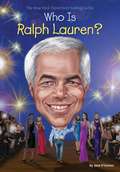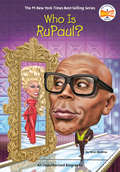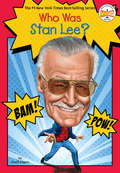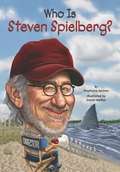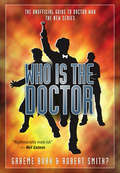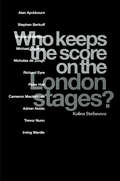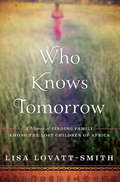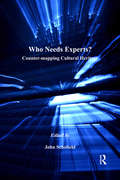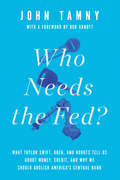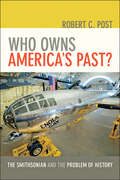- Table View
- List View
Who Did It First? 50 Scientists, Artists, and Mathematicians Who Revolutionized the World: 50 Scientists, Artists, And Mathematicians Who Revolutionized The World (Who Did It First? #1)
by Julie LeungA boldly illustrated and fascinating collection of profiles featuring the women and men who were pioneers of science, technology, engineering, the arts, and mathematics.You likely know that Mae Jemison was the first African American woman in space. And maybe you know that Jane Goodall was the first human accepted into a chimpanzee community. But you might not know that Alan Turing was the first person to introduce the concept of artificial intelligence. Or that Tu Youyou was the first Chinese woman to win a Nobel Prize. Who Did It First? 50 Scientists, Artists, and Mathematicians Who Revolutionized the World brings together all of these trailblazers into one stunning package. With both well-known figures and lesser-known heroes, editor Alex Hart, writer Julie Leung, and illustrator Caitlin Kuhwald celebrate the inspiring innovators who braved uncharted waters to pave the path for future generations.Perfect for fans of Little Leaders, Women in Science, and Rad Women Worldwide, Who Did It First? makes a wonderful gift for any occasion and is a must-have for every young reader’s library.Featuring Ada Lovelace, Mindy Kaling, Temple Grandin, Maria Tallchief, Riz Ahmed, and many others.
Who Goes There: Travels Through Strangest Britain In Search Of The Doctor
by Nick GriffithsThe author of Dalek I Loved You charts his travels through England and Wales tracking down locations used in Doctor Who, both classic and new. Being an odd kind of show, Doctor Who&’s locations too are odd. This is no glamorous trip. Dungeness Nuclear Power Station, anyone? A flooded china clay pit in Cornwall? As he travels, so Nick Griffiths discovers another side to his well-trodden country, which is no less evocative. Then he goes to the pub. As in his previous memoir Dalek I Loved You, the travel writing is backed up by Nick&’s childhood reminiscences and contemporary musings. A companion website offers photographs from the trip, a Google map of the locations, and details of the nearest pub. In this innovative way, readers are invited to follow in his footsteps. Who Goes There isn&’t just for Who fans, it&’s a very funny book for anyone who fancies a trip off the beaten path. Praise for Dalek I Loved You &“A very funny book for anyone who grew up wearing Tom Baker underpants. I know I did.&”—David Tennant &“An unadulterated nostalgia-fest written with fun, wit and love.&”—Doctor Who Magazine &“He conjures up just how mind-blowing it was for an ordinary suburban kid to be transported to a realm of danger and rampant sci-fi imaginings.&”—Financial Times &“If I am getting carried away, it is the fault of Griffiths&’s awfully charming memoir of boyhood and Doctor Who, with its deft evocations of eight-year-old invincibility and embarrassing school discos as well as arguments about Cybermen vs Autons or Jon Pertwee vs Tom Baker. Griffiths&’s chatty, self-deprecating style is disarming.&”—The Guardian
Who I Am and What I Want
by David ShrigleyThe internationally acclaimed pop artist offers his dementedly clever perspective on everything from dolphins, boredom, and beer to supernatural forces.With deadpan humor and unsettling imagery, Scottish pop artist David Shrigley’s scrawls from the subconscious have earned him major gallery showings and legions of fans. In this mock autobiographical collection, his mischievous drawings capture life’s anxieties and ambitions from the mundane to the surreal. Seductively strange and addictively amusing, this edgy book welcomes the uninitiated and rewards the faithful.
Who Invented Oscar Wilde?: The Photograph at the Center of Modern American Copyright
by David NewhoffIn early 1882, before young Oscar Wilde embarked on his lecture tour across America, he posed for publicity photos taken by a famously eccentric New York photographer named Napoleon Sarony. Few would guess that one of those photographs would become the subject of the Supreme Court case that challenged copyright protection for all photography—a constitutional question that asked how a machine-made image could possibly be a work of human creativity.Who Invented Oscar Wilde? is a story about the nature of authorship and the &“convenient fiction&” we call copyright. While a seemingly obscure topic, copyright has been a hotly contested issue almost since the day the internet became publicly accessible. The presumed obsolescence of authorial rights in this age of abundant access has fueled a debate that reaches far beyond the question of compensation for authors of works. Much of the literature on the subject is either highly academic, highly critical of copyright, or both. With a light and balanced touch, David Newhoff makes a case for intellectual property law, tracing the concept of authorship from copyright&’s ancient beginnings to its adoption in American culture to its eventual confrontation with photography and its relevance in the digital age. Newhoff tells a little-known story that will appeal to a broad spectrum of interests while making an argument that copyright is an essential ingredient to upholding the principles on which liberal democracy is founded.
Who Is Alex Trebek?: A Biography
by Lisa RogakNew York Times–Bestselling Author: This biography of the Jeopardy! host “masterfully illustrates how and why he remains a treasured entertainment icon” (Booklist).After a contestant wrote “We love you, Alex!” as his Final Jeopardy! answer, fans around the world quickly chimed in to proclaim their own love and support for beloved Jeopardy! host Alex Trebek. In the wake of his devastating cancer diagnosis, the moment provided the perfect opportunity to reflect on what the show—and the man—meant to them.It was no surprise, since millions of viewers considered Alex Trebek a part of their daily lives ever since he began hosting the show in 1984. Now biographer Lisa Rogak gives readers a look at Trebek’s early life, career, and personal life throughout the years, drawing on many sources to tell his full story for the first time.There are many surprises, like the fact that Trebek was almost fifty when he discovered he had a half brother, as well as the revelation that for a short time he actually dreamed of becoming a priest. The native Canadian also struggled with depression after the failure of his first marriage, and for years afterward despaired of ever having a family of his own, until he met the woman who would become his soulmate.Who Is Alex Trebek? is the first biography of the much-loved game show host, and as such, celebrates the man who has created a remarkable legacy that will live on in popular culture for generations to come.“Entertaining . . . Rogak depicts Trebek as exactly the man most viewers imagine, or hope, he would be—generous, curious about the world, genuinely enjoying the work he does and taking it seriously.” —BookReporter
Who Is Carol Burnett? (Who Was?)
by Who HQ David StablerDiscover why comedian and actress Carol Burnett is one of the most iconic entertainers of the twentieth century.From an early age, Carol Burnett developed a love for entertainment, teaching herself to "Tarzan yell" at age nine. After graduating from high school, Burnett studied theater arts and English at UCLA, which only solidified her passion for acting. She fell in love with making audiences laugh, landing her first breakthrough role in Broadway's Once Upon a Mattress. Since then, Burnett went on to perform on programs like The Garry Moore Show and Julie and Carol at Carnegie Hall. In 1967, The Carol Burnett Show was born, breaking ground and earning her several Emmys and Golden Globes. The show ran for eleven seasons. Young readers can learn more about the life and legacy of beloved comedian Carol Burnett in this exciting new book!
Who Is George Lucas?
by Meg Belviso Pamela D. Pollack Ted Hammond Kevin McveighAs a child his passions were comics and cars, but George Lucas grew up to be one of the most successful filmmakers of all time. He is a producer, screenwriter, director and entrepreneur whose company Lucasfilms pioneered the movie effects that changed the world of animation. He founded Industrial Light and Magic, which transformed special sound and visual effects throughout the Hollywood film industry. He is best known, of course, as the creator of the Star Wars movie, television, gaming, toy and merchandise empire, as well as the archeologist-adventure series Indiana Jones. Discover the man behind the magic in Who Is George Lucas?
Who Is In the Room?: Queer Strategies for Redefining the Role of the Theater Director (ISSN)
by Brooke O'HarraWith this book, Brooke O’Harra takes up directing as an artistic practice in and of itself. Speaking beyond and against craft, O’Harra drives the art of directing forward.O’Harra investigates a series of important questions: How do we wrest our work from institutional imperatives of public building and culture building? How can an artist-driven discourse lead us toward the urgencies of artists and their publics in this moment? How do we “make” plays? How do we activate the relationships of making, whether between artists in the rehearsal room or between the production and the audience? Brooke addresses all aspects of the directorial process: reckoning with the script through dramaturgy, working within the rehearsal room, collaborating with other artists, as well as staging and production.This exploration will be of great interest to students and scholars in performance studies with a particular interest in directing.
Who Is Jackie Chan? (Who Was?)
by Who HQ Jody Jensen ShafferHow did Jackie Chan become one of the most recognizable and beloved actors in the world? Find out in this exciting biography of this martial artist turned international film superstar.When Kong-sang was a young boy in Hong Kong, he enjoyed practicing martial arts with his dad but hated going to school. He was eventually enrolled in the China Drama Academy, where he improved his martial arts skills and became a stuntman. That training led to a successful career as an actor. Kong-sang, now known as Jackie Chan, never gave up on his passion for screwball physical comedy. Luckily for Jackie, his determination paid off. His humor and dangerous stuntwork in films like Cannonball Run, Rush Hour, Shanghai Noon, and Karate Kid have made him an international star, and it doesn't look like he'll be leaving the big screen anytime soon.
Who Is Jeff Kinney?
by Patrick Kinney John HinderliterEven as a kid, everyone thought Jeff Kinney was talented. People loved his drawings, and when he went to college, his comic strip Igdoof was so popular that it spread to other universities! Still, Jeff faced challenges. His cartoons were rejected by syndicates that claimed his art was unprofessional. Then, an idea struck: Jeff would write a journal from the perspective of a child, illustrated with doodles just like a kid might do. And so, the Diary of a Wimpy Kid series was born--and it was a hit! In this biography, Jeff's brother, Patrick Kinney, provides a knowledgeable look at the life of this best-selling author/illustrator. From Jeff's childhood pranks to his job developing online games, kids will love the chance to learn more about the creator of the popular Wimpy Kid books.
Who Is Ken Jennings? (Who HQ Now)
by Kirsten Anderson Who HQPart of the #1 New York Times bestselling series, this Who HQ Now book tells the amazing story of an unknown trivia buff who became the all-time greatest contestant on Jeopardy! Ken Jennings is considered the greatest of all-time contestants on Jeopardy! and became a household name after his impressive 74-game winning streak. After the passing of longtime host Alex Trebek, Jennings became the first guest to host Jeopardy! Read more about Ken Jennings and his curious life in this Who HQ Now biography.
Who Is Maria Tallchief?
by Catherine GourleyBorn in 1925, Maria Tallchief spent part of her childhood on an Osage reservation in Oklahoma. With the support of her family and world-renowned choreographer George Balanchine, she rose to the top of her art form to become America's first prima ballerina.
Who Is Oprah Winfrey? (Who Was?)
by Barbara Kramer Who HQThe story of how a young Southern girl who was raised on a pig farm became one of the most influential and inspiring people in the world.We all know Oprah Winfrey as a talk-show host, actress, producer, media mogul, and philanthropist, but the "Queen of Talk" wasn't always so fortunate. She suffered through a rough childhood and went on to use her personal struggles as motivation. Oprah's kindness, resilience, and determination are just some of the many reasons why her viewers--and people all around the world--love her. The richest African American person of the twentieth century, Oprah is often described as the most influential woman in the world.
Who Is Ralph Lauren? (Who was?)
by Jane O'Connor Stephen Marchesi Who HqThe polo player with the raised mallet—everyone knows the Ralph Lauren logo. Learn the amazing story of the man who is a true American fashion icon.Born in the Bronx, even as a teenager Ralph Lauren was known for his distinctive fashion sense, having a taste for both classic preppy clothes and vintage looks like beat-up leather jackets. He got his start in the fashion business by selling ties that he designed. From ties he went on to create a global fashion empire. In this easy-to-read biography, best-selling author and Who Was? creator Jane O'Connor explains exactly how a fashion line is created—from first drawings to models strutting on the runway.
Who Is RuPaul? (Who Was?)
by Nico Medina Who HQLearn how this Emmy-winning host, producer, and television personality became the world's most famous drag queen.RuPaul Andre Charles always knew he was meant to be a performer. Even as a young child, he loved to dress up and imitate the glamorous women he saw on television. When he turned fifteen, he began studying theater in a performing arts school in Atlanta and never looked back. Ru developed his drag-queen personality and launched his career in the 1980s. He now hosts and judges the widely popular and long-running show RuPaul's Drag Race, which has raised the profile of the art of drag, and drag queens around the world.
Who Is Stan Lee? (Who was?)
by Geoff Edgers Nancy Harrison John HinderliterStanley Lieber was just seventeen when he got his first job at Timely Comics in 1939. Since then, the man now known as Stan Lee has launched a comic book empire, made Marvel Comics a household name, and created iconic superheroes such as Iron Man, Spider-Man, and the Fantastic Four. Stan Lee is still dreaming up caped crusaders and masked vigilantes in his nineties. Who Is Stan Lee? tells the story of a New York City kid with a superhero-sized imagination.
Who Is Steven Spielberg?
by Stephanie Spinner Daniel MatherWhile other kids played sports, Steven Spielberg was writing scripts and figuring out camera angles. He went from entertaining his Boy Scout troop with home movies to amazing audiences around the world with epic blockbusters. He has directed four of the most successful films of all time and has won two Academy Awards for Best Director. From Jaws to Lincoln, young readers and aspiring filmmakers will be fascinated by the life of this famous director.
Who Is the Doctor: The Unofficial Guide to Doctor Who: The New Series (Who Is the Doctor #1)
by Robert Smith Graeme Burk&“A joyful celebration of fan love. Unofficial episode guides don&’t come much more engaging than this&” (Benjamin Cook, co-author of Doctor Who: The Writer&’s Tale). Doctor Who was already the world&’s longest-running science fiction series when it returned in 2005 to huge success. Enormously popular, the BBC show encompasses multiple other genres, from horror to comedy to action and historical adventure, and is loved for its uniquely British wit and clever scripting. Its hero, its monsters, and even its theme song have become pop culture icons. In this volume covering six seasons of the new series, two Doctor Who experts provide insights into everything from the history of the show, including Daleks, Cybermen, and the eight Classic Series Doctors, to a detailed episode guide. As Neil Gaiman complained to the authors, &“I have just lost four hours to your blasted book. And I only meant to glance at it.&” Allons-y!
Who Keeps the Score on the London Stages?
by Kalina StefanovaHow does one become a theater critic in London? What do the theater critics think of their profession? How are they judged by those they critique? What do both critics and theatre-makers think of their mutual object of desire - the British Theatre?Who Keeps the Score on the London Stages? sets out to find the answers to these questions and many more in this long overdue publication on Britain's current theatre scene. Included are comprehensive interviews with more than fifty major London theatre critics and theater-makers, including Sir Alan Ayckbourn, Stephen Berkoff, Michael Billington, Martin Coveney, Nicholas de Jongh, Sir Richard Eyre, Sir Peter Hall, Sir Cameron Mackintosh, Adrian Noble, Sir Trevor Nunn and Irving Wardle. The author has gathered together a lively discussion about the contrmporary state of the British theatre, drawing a picture of its strengths, weaknesses and the problems it faces today. This volume serves as a long overdue guide to the Theatre critics' profession in Britain.
Who Killed Tom Thomson?: The Truth about the Murder of One of the 20th Century's Most Famous Artists
by John LittleTom Thomson was Canada's Vincent van Gogh. He painted for a period of five years before meeting his untimely death in a remote wilderness lake in July 1917. He was buried in an unofficial grave close to the lake where his body was found. About eight hours after he was buried, the coroner arrived but never examined the body and ruled his death accidental due to drowning. A day and a half later, Thomson's family hired an undertaker to exhume the body and move it to the family plot about 100 miles away. This undertaker refused all help, and only worked at night. In 1956, John Little's father and three other men, influenced by the story of an old park ranger who never believed Thomson's body was moved by the undertaker, dug up what was supposed to be the original, empty grave. To their surprise, the grave still contained a body, and the skull revealed a head wound that matched the same location noted by the men who pulled his corpse from the water in 1917. The finding sent shockwaves across the nation and began a mystery that continues to this day. In Who Killed Tom Thomson? John Little continues the sixty-year relationship his family has had with Tom Thomson and his fate by teaming up with two high-ranking Ontario provincial police homicide detectives. For the first time, they provide a forensic scientific opinion as to how Thomson met his death, and where his body is buried. Little draws upon his father's research, plus recently released archival material, as well as his own thirty-year investigation. He and his colleagues prove that Thomson was murdered, and set forth two persons of interest who may have killed Tom Thomson.
Who Knows Tomorrow: A Memoir of Finding Family among the Lost Children of Africa
by Lisa Lovatt-SmithBorn in Spain and raised by a struggling single mother, Lisa Lovatt-Smith became an editor at British Vogue at nineteen, the youngest in Condé Nast history. She helped launch Spanish Vogue and partied across Europe with celebrities, fashion designers, photographers, and supermodels. By her thirties, Lisa has her dream career and a glamorous life in Paris, but when her adopted daughter Sabrina is expelled from school, Lisa takes her to volunteer in a Ghanaian orphanage in the hopes of getting her back on track. What she discovers there changes both their lives for good. Appalled by the deplorable conditions she finds, Lisa moves to Ghana permanently and founds OAfrica, dedicating her personal resources to reuniting hundreds of Ghanaian children with their families and spearheading a drive to shut down corrupt orphanages. On this unforgettable journey, Lisa confronts death threats, malaria, arson, and heartbreaking poverty; she also discovers truly inspiring children trapped in limbo by a moneymaking scheme bigger than she ever imagined. Who Knows Tomorrow is the engaging, frank, and often surprisingly funny story of one amazing woman who has traveled the globe in search of meaningful connection. Although to Lisa her story will always be about the children, it’s also a touching celebration of a woman who is talented, generous, and unfailingly courageous.
Who Needs Experts?: Counter-mapping Cultural Heritage (Heritage, Culture and Identity)
by John SchofieldTaking the significant Faro Convention on the Value of Cultural Heritage for Society (Council of Europe 2005) as its starting point, this book presents pragmatic views on the rise of the local and the everyday within cultural heritage discourse. Bringing together a range of case studies within a broad geographic context, it examines ways in which authorised or 'expert' views of heritage can be challenged, and recognises how everyone has expertise in familiarity with their local environment. The book concludes that local agenda and everyday places matter, and examines how a realignment of heritage practice to accommodate such things could usefully contribute to more inclusive and socially relevant cultural agenda.
Who Needs the Fed?: What Taylor Swift, Uber, and Robots Tell Us About Money, Credit, and Why We Should Abolish America's Central Bank
by John TamnyThe Federal Reserve is one of the most disliked entities in the United States at present, right alongside the IRS. Americans despise the Fed, but they're also generally a bit confused as to why they distrust our central bank.Their animus is reasonable, though, because the Fed's most famous function-targeting the Fed funds rate-is totally backwards. John Tamny explains this backwardness in terms of a Taylor Swift concert followed by a ride home with Uber.In modern times, he points out, the notion of credit has been perverted, so that most people believe it's money and that the supply of it can therefore be increased. This false notion has aggrandized the Fed with power that it can't possibly use wisely. The contrast between the grinding poverty of Baltimore and the abundance of Silicon Valley helps illustrate the problem, along with stories about Donald Trump, Robert Downey Jr., Jim Harbaugh (the Michigan football coach), and robots.Who Needs the Fed? makes a sober case against the Federal Reserve by explaining what credit really is, and why the Fed's existence is inimical to its creation. Readers will come away entertained, much more knowledgeable, and prepared to argue that the Fed is merely superfluous on its best days but perilous on its worst.
Who Owns America's Past?: The Smithsonian and the Problem of History
by Robert C. PostWhen preserving our history, what do we choose to value, why, and who decides?Honorable Mention for the National Council on Public History Book Award of the National Council on Public HistoryIn 1994, when the National Air and Space Museum announced plans to display the Enola Gay, the B-29 sent to destroy Hiroshima with an atomic bomb, the ensuing political uproar caught the museum's parent Smithsonian Institution entirely unprepared. As the largest such complex in the world, the Smithsonian cares for millions of objects and has displayed everything from George Washington's sword to moon rocks to Dorothy’s ruby slippers from The Wizard of Oz. Why did this particular object arouse such controversy? From an insider’s perspective, Robert C. Post’s Who Owns America’s Past? offers insight into the politics of display and the interpretation of history.Never before has a book about the Smithsonian detailed the recent and dramatic shift from collection-driven shows, with artifacts meant to speak for themselves, to concept-driven exhibitions, in which objects aim to tell a story, displayed like illustrations in a book. Even more recently, the trend is to show artifacts along with props, sound effects, and interactive elements in order to create an immersive environment. Rather than looking at history, visitors are invited to experience it.Who Owns America’s Past? examines the different ways that the Smithsonian’s exhibitions have been conceived and designed—whether to educate visitors, celebrate an important historical moment, or satisfy donor demands or partisan agendas. Combining information from hitherto-untapped archival sources, extensive interviews, a thorough review of the secondary literature, and considerable personal experience, Post gives the reader a behind-the-scenes view of disputes among curators, academics, and stakeholders that were sometimes private and at other times burst into headline news.
Who Owns Antiquity? Museums and the Battle Over Our Ancient Heritage
by James CunoWhether antiquities should be returned to the countries where they were found is one of the most urgent and controversial issues in the art world today, and it has pitted museums, private collectors, and dealers against source countries, archaeologists, and academics. Maintaining that the acquisition of undocumented antiquities by museums encourages the looting of archaeological sites, countries such as Italy, Greece, Egypt, Turkey, and China have claimed ancient artifacts as state property, called for their return from museums around the world, and passed laws against their future export. But in Who Owns Antiquity?, one of the world's leading museum directors vigorously challenges this nationalistic position, arguing that it is damaging and often disingenuous. "Antiquities," James Cuno argues, "are the cultural property of all humankind," "evidence of the world's ancient past and not that of a particular modern nation. They comprise antiquity, and antiquity knows no borders." Cuno argues that nationalistic retention and reclamation policies impede common access to this common heritage and encourage a dubious and dangerous politicization of antiquities--and of culture itself. Antiquities need to be protected from looting but also from nationalistic identity politics. To do this, Cuno calls for measures to broaden rather than restrict international access to antiquities. He advocates restoration of the system under which source countries would share newly discovered artifacts in exchange for archaeological help, and he argues that museums should again be allowed reasonable ways to acquire undocumented antiquities. Cuno explains how partage broadened access to our ancient heritage and helped create national museums in Cairo, Baghdad, and Kabul. The first extended defense of the side of museums in the struggle over antiquities, Who Owns Antiquity? is sure to be as important as it is controversial.
